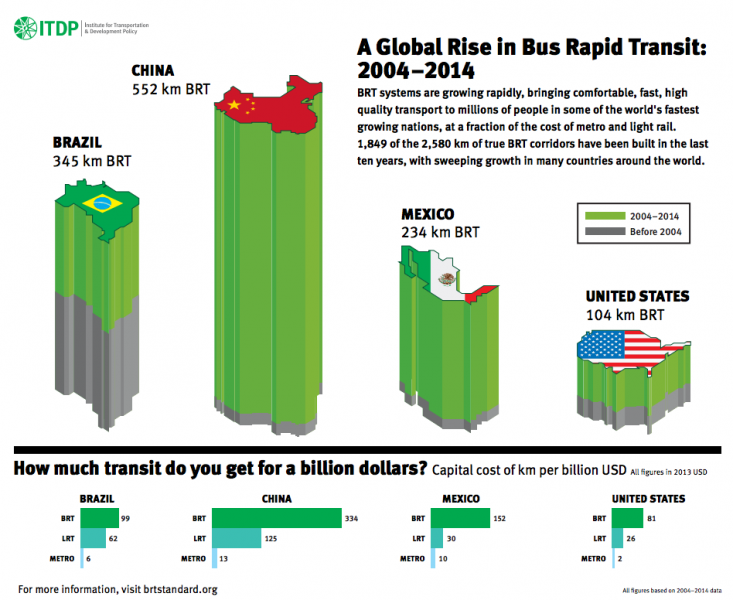Bus Rapid Transit Nearly Quadruples Over Ten Years, says ITDP
Bus rapid transit has grown by 383 percent in the last ten years, according to new data released by Institute for Transportation and Development Policy (ITDP). As cities around the world discover the benefits and cost effectiveness of BRT, they have built hundreds of systems across dozens of countries that qualify as true BRT. A new interactive map shows a comprehesive list of BRT systems globally, based on in depth data of systems scored in 2013 and 2014.
“Cities around the world are seeing their populations surge, and existing transportation systems are struggling to keep up, resulting in unprecedented congestion and pollution. For developing cities to compete globally, they urgently need high quality public transportation,” says Jacob Mason, Transport Research and Evaluation Manager for ITDP, “Fortunately, governments around the world are increasingly turning to BRT as a cost-effective solution that can be implemented quickly. We’re seeing that when it’s done well, BRT attracts large ridership and can provide similar levels of speed, capacity, and comfort as metro and light rail transit options.”
While growth has been strongest in rapidly urbanizing parts of the world such as China, Brazil, and Indonesia, there has also been substantial growth in the United States and France. China is the global leader in BRT, having added 538 kilometers of BRT in the last ten years, dramatically up from only one system of 14 km in 2004. Costs vary across nations, but BRT capital costs are generally less than ten percent of the cost of metro, and 30-60 percent of the cost of light rail. BRT can also be implemented much more quickly that rail-based transit, allowing systems to be created and expanded quickly to meet ever growing needs.
“As fast as BRT has grown in the last ten years, we fully expect this trend to continue over the next ten years, as more and more cities and countries discover the benefits of BRT, ” says Mason, “China, India, and Central and Southeast Asia all have multiple new systems in development, and we’re really excited about the potential of Africa, the most rapidly urbanizing continent, where work on BRT systems is progressing in Tanzania, Uganda, Kenya, South Africa, and Egypt.”
Similar to the LEED designation for green buildings, BRT corridors may achieve a basic BRT, bronze, silver or gold designation. A committee of the world’s foremost experts in bus rapid transit design has worked together to fully score 98 corridors in 62 cities using The BRT Standard. The data is endorsed by Rockefeller Foundation, Barr Foundation, ClimateWorks Foundation, GIZ, ICCT, UNEP, and UN Habitat.
Of the 98 scored corridors, 15 are classified as gold, 28 as silver, 41 as bronze, and 6 as “basic” BRT, indicating a minimum of BRT features, but not quite qualifying as best practice. Eight systems did not qualify as BRT. Furthermore, ITDP has identified 200 addition corridors that preliminarily meet the BRT basics. For complete scorecards and a breakdown of categories, visit brtstandard.org.
This is a blog post originally published by ITDP at https://www.itdp.org/bus-rapid-transit-nearly-quadruples-ten-years/.
